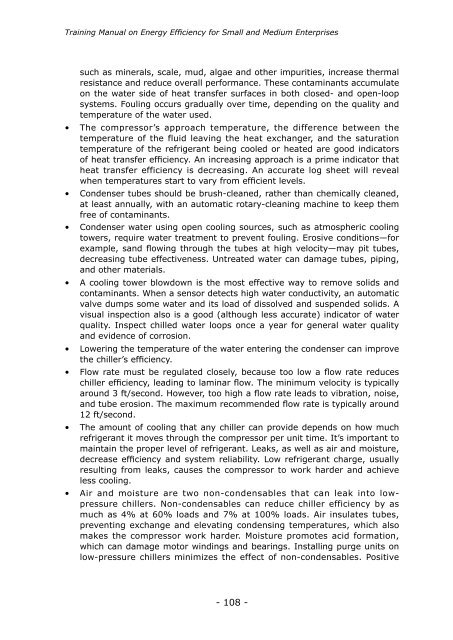Training Manual on Energy Efficiency - APO Asian Productivity ...
Training Manual on Energy Efficiency - APO Asian Productivity ...
Training Manual on Energy Efficiency - APO Asian Productivity ...
Create successful ePaper yourself
Turn your PDF publications into a flip-book with our unique Google optimized e-Paper software.
<str<strong>on</strong>g>Training</str<strong>on</strong>g> <str<strong>on</strong>g>Manual</str<strong>on</strong>g> <strong>on</strong> <strong>Energy</strong> <strong>Efficiency</strong> for Small and Medium Enterprises<br />
such as minerals, scale, mud, algae and other impurities, increase thermal<br />
resistance and reduce overall performance. These c<strong>on</strong>taminants accumulate<br />
<strong>on</strong> the water side of heat transfer surfaces in both closed- and open-loop<br />
systems. Fouling occurs gradually over time, depending <strong>on</strong> the quality and<br />
temperature of the water used.<br />
• The compressor’s approach temperature, the difference between the<br />
temperature of the fluid leaving the heat exchanger, and the saturati<strong>on</strong><br />
temperature of the refrigerant being cooled or heated are good indicators<br />
of heat transfer efficiency. An increasing approach is a prime indicator that<br />
heat transfer efficiency is decreasing. An accurate log sheet will reveal<br />
when temperatures start to vary from efficient levels.<br />
• C<strong>on</strong>denser tubes should be brush-cleaned, rather than chemically cleaned,<br />
at least annually, with an automatic rotary-cleaning machine to keep them<br />
free of c<strong>on</strong>taminants.<br />
• C<strong>on</strong>denser water using open cooling sources, such as atmospheric cooling<br />
towers, require water treatment to prevent fouling. Erosive c<strong>on</strong>diti<strong>on</strong>s—for<br />
example, sand flowing through the tubes at high velocity—may pit tubes,<br />
decreasing tube effectiveness. Untreated water can damage tubes, piping,<br />
and other materials.<br />
• A cooling tower blowdown is the most effective way to remove solids and<br />
c<strong>on</strong>taminants. When a sensor detects high water c<strong>on</strong>ductivity, an automatic<br />
valve dumps some water and its load of dissolved and suspended solids. A<br />
visual inspecti<strong>on</strong> also is a good (although less accurate) indicator of water<br />
quality. Inspect chilled water loops <strong>on</strong>ce a year for general water quality<br />
and evidence of corrosi<strong>on</strong>.<br />
• Lowering the temperature of the water entering the c<strong>on</strong>denser can improve<br />
the chiller’s efficiency.<br />
• Flow rate must be regulated closely, because too low a flow rate reduces<br />
chiller efficiency, leading to laminar flow. The minimum velocity is typically<br />
around 3 ft/sec<strong>on</strong>d. However, too high a flow rate leads to vibrati<strong>on</strong>, noise,<br />
and tube erosi<strong>on</strong>. The maximum recommended flow rate is typically around<br />
12 ft/sec<strong>on</strong>d.<br />
• The amount of cooling that any chiller can provide depends <strong>on</strong> how much<br />
refrigerant it moves through the compressor per unit time. It’s important to<br />
maintain the proper level of refrigerant. Leaks, as well as air and moisture,<br />
decrease efficiency and system reliability. Low refrigerant charge, usually<br />
resulting from leaks, causes the compressor to work harder and achieve<br />
less cooling.<br />
• Air and moisture are two n<strong>on</strong>-c<strong>on</strong>densables that can leak into lowpressure<br />
chillers. N<strong>on</strong>-c<strong>on</strong>densables can reduce chiller efficiency by as<br />
much as 4% at 60% loads and 7% at 100% loads. Air insulates tubes,<br />
preventing exchange and elevating c<strong>on</strong>densing temperatures, which also<br />
makes the compressor work harder. Moisture promotes acid formati<strong>on</strong>,<br />
which can damage motor windings and bearings. Installing purge units <strong>on</strong><br />
low-pressure chillers minimizes the effect of n<strong>on</strong>-c<strong>on</strong>densables. Positive<br />
- 108 -
















